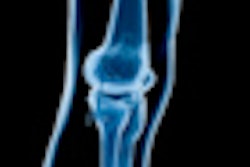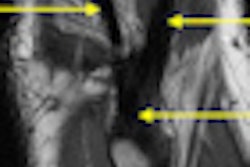Using 1-tesla MRI, researchers with the Multicenter Osteoarthritis Study (MOST) have found that prevalent cartilage damage and cartilage loss "strongly predict" bone marrow lesions and support the progression of knee osteoarthritis.
In addition, the MOST study also concluded that meniscal tears are associated with meniscal extrusion, through which the meniscus can be dislocated as a result of the osteoarthritis process. The findings were discussed this month at the 2011 European Congress of Radiology (ECR) in Vienna in two presentations by Dr. Michel Crema, lead author and assistant professor of radiology at Boston University School of Medicine.
MOST's goals
MOST is a multicenter, prospective, observational study of risk factors that contribute to the development and progression of knee osteoarthritis and knee pain. The initiative is sponsored by the U.S. National Institutes of Health and the U.S. Department of Health and Human Services' National Institute on Aging.
One goal of the research is to determine how physical activities, weight, diet, and other factors affect osteoarthritis, which is the most common form of arthritis and disease in the knee and a leading cause of disability.
In the research described in the first ECR presentation, the study group sought to assess the association of prevalent cartilage damage and cartilage loss over time with incident bone marrow lesions in the same subregion of the knee. Bone marrow lesions are known predictors of cartilage loss in knee osteoarthritis. That loss of cartilage can cause the removal of tissue protecting the underlying bone, increasing potential bone damage.
A total of 1,284 people with or at risk of knee osteoarthritis were enrolled, and patients received a baseline 1-tesla MRI scan and 30-month follow-up. Cartilage morphology was scored from 0 to 6, with bone marrow lesions rated from 0 to 3.
Researchers defined baseline cartilage damage as a grade of 2 or greater. Patients with cartilage loss were divided into two groups: incident cartilage damage (grade 0 at baseline and 2 or greater at follow-up) and progression of cartilage damage (baseline cartilage damage and increased grade at follow-up).
Incident bone marrow lesions were defined as grade 0 at baseline and grade 1 or greater at follow-up.
Strong predictor
The MOST analysis found that baseline cartilage damage, incident cartilage loss, and progression of cartilage loss were associated medially with incident bone marrow lesions. Thus, prevalent cartilage damage and incident cartilage loss "strongly predict" bone marrow lesions and the "close interrelation of the osteochondral unit in the progression of knee osteoarthritis."
In the second ECR presentation, Crema discussed how researchers evaluated the associations of meniscal tears, knee malalignment, cartilage damage, and body mass index with meniscal extrusion. "Understanding risk factors for meniscal extrusion is important in order to develop targeted treatment," according to the researchers.
A total of 1,527 patients with baseline radiographs and 1-tesla MRI scans were evaluated. Meniscal tears were graded on a scale from 0 to 4, with grades 1 or greater exhibiting meniscal tears. Meniscal extrusion was graded from 0 to 2; grades 1 or greater were considered cases of extrusion.
In addition, tibiofemoral cartilage morphology was ranked from 0 to 6, with grades 2 or greater representing cases of cartilaginous defects.
Meniscal factor
The analysis found that meniscal tears, varus malalignment (knees wide apart, or bow-legged), and cartilage damage were significantly associated medially with meniscal extrusion. In addition, meniscal tears, valgus malalignment (knees close together and ankles apart, or knock-kneed), and cartilage damage were significantly associated laterally with meniscal extrusion.
There was no association between meniscal extrusion and body mass index.
Meniscal tears are associated with meniscal extrusion "but also other factors, such as knee malalignment and cartilage damage," Crema and colleagues noted, adding that meniscal extrusion "is a result of the complex interrelation of the different joint tissues involved in the osteoarthritis process."



















